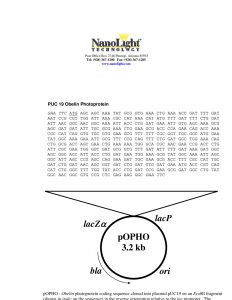product Products
This is where you can browse products in this store.
| Cat# | Name | |||||||||||||||
|---|---|---|---|---|---|---|---|---|---|---|---|---|---|---|---|---|
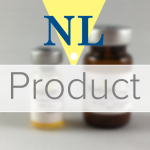
| 333 | A buffer used for cells expressing Firefly, Renilla and Oplo ... | 
This buffer provides optimal lysis conditions for cells expressing Firefly, Renilla and Oplophorus (NanoLuc, NanoKAZ) luciferases.
The proprietary formula has stabilizing properties and will enhance the performance of the expressed luciferase.
This lysis-buffer is compatible with the following Luciferase Assay ReagentsWe offer a special discount if you purchase the lysis-buffer with one of our Luciferase Assays. Please select “add Lysis” under product options on the Luciferase buffer website. For intracellular expressed Gaussia Luciferase please use the lysisbuffer provided with the GLuc FLASH kit (Cat.#319) The buffer can be stored at 4°C for up to one year or at least for 5 years at -20°C. | |||||||||||||
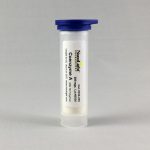
| 309 | Coenzyme A will prolong the signal of Firefly Luciferase Bio ... | 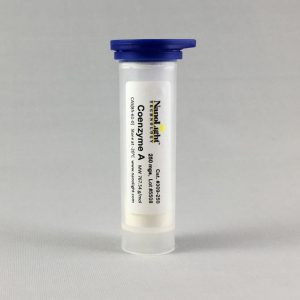
Coenzyme A will prolong the signal of Firefly Luciferase Bioluminescence 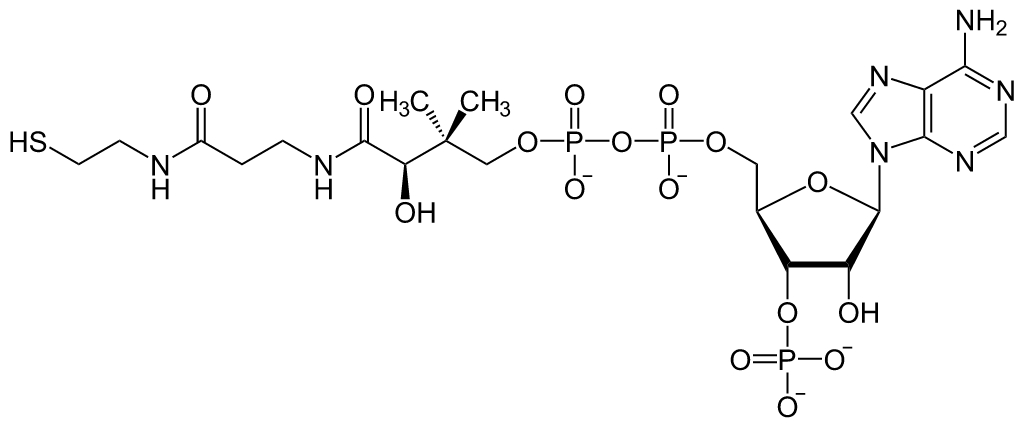
| |||||||||||||
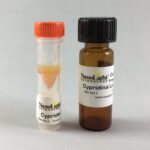
| 305 | also known as Vargula Luciferin or Vargulin,
enantiomeric ... | 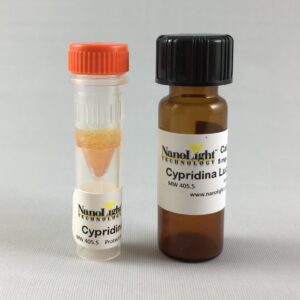
also known as Vargula Luciferin or Vargulin, enantiomeric mixture: 70% S-form, 30% R-form both forms are luminous active
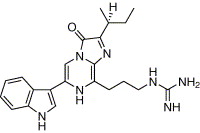
Cypridina was first characterized by Dr Osamu and Akemi Shimomura from “Umi Hotaru” Japanese Sea Fireflies in 1966. These are bottom dwelling ostracods that emit a light stream into water when disturbed presumably to deter predation. Cypridina Luciferase was first cloned by Eric Thompson, and S. Nagata under Fred Tsuji in Japan 1989. Cypridina is a 555 amino acid, 62.171 KDa protein that oxidizes the luciferin to produce blue light at 462 nm Em Max. The advantage of using the Cypridna system: it does not cross react with Coelenterazine or Firefly d-Luciferin so it may be used in multiplex assays. It is brighter then Firefly Luciferase. Natural occurring Cypridina Luciferin is 100% S-form. NanoLights Cypridina synthesized compound is an enantiomeric mixture of 70% S and 30% R form. The recently published paper describes that the R-form is also a luminous substrate for Cypridina Luciferase with a 3-fold lower turnover rate and not a competitive inhibitor as previously thought. Therefore, a negative impact on Cypridina bioluminescent assays is not expected. We would like to thank the authors for the detailed analysis of our product. Kanie S, Wu C, Kihira K, Yasuno R, Mitani Y, Ohmiya Y. Bioluminescence of (R)-Cypridina Luciferin with Cypridina Luciferase. Int J Mol Sci. 2024 Feb 26;25(5):2699. Inouye S. Pink-colored Cypridina luciferase from Cypridina (Vargula) hilgendorfii: Oxygen-triggered luminescence reaction following NAD(P)H-FMN flavin reductase reaction. Biochem Biophys Res Commun. 2025 Feb 2;747:151285. The advantages of lyophilized luciferins are:
The luciferin is shipped as filtered, lyophilized, batch controlled substrate | |||||||||||||

| 
| |||||||||||||||
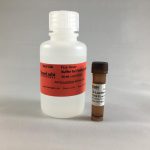
| 318 | The NanoFuel® Assay kit for Firefly Luciferase kit provides ... | 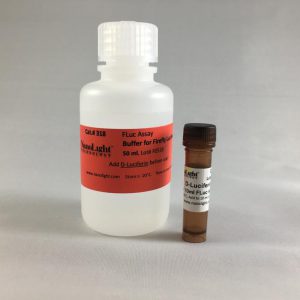
The NanoFuel® Assay kit for Firefly Luciferase kit provides enough buffer for approx. 1000 assays. Optimized buffer conditions will give you the best signal over a half-life of 45 min. Therefore no injection luminometer is required. This kit can be used for high-throughput screenings due to its steady signal. FLuc Assay Kit content
Properties of FLuc Assay Buffer
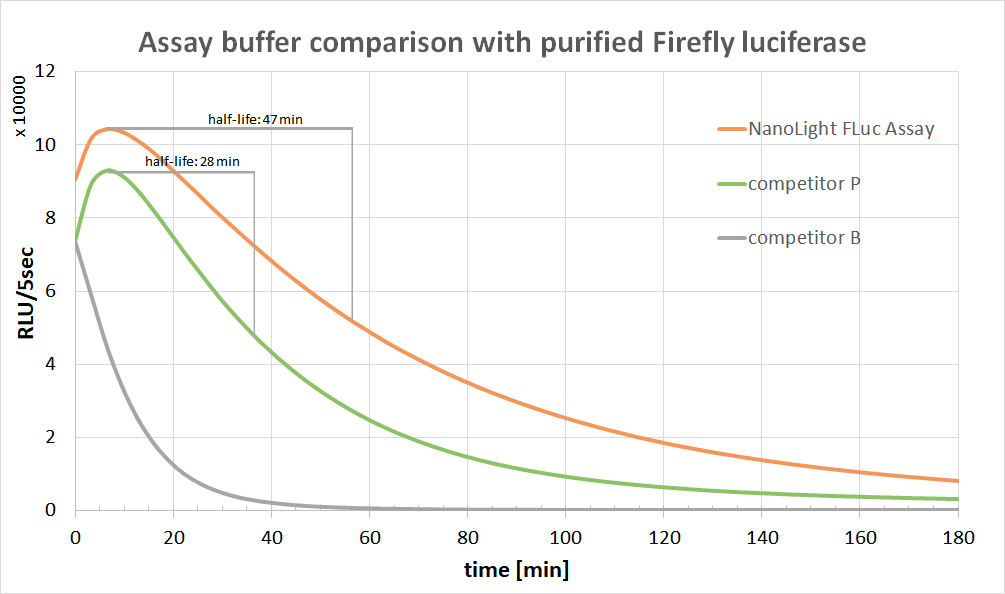
| |||||||||||||
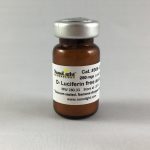
| 306 | Firefly D-Luciferin Free Acid >99% (Photinus pyralis, pyr ... | 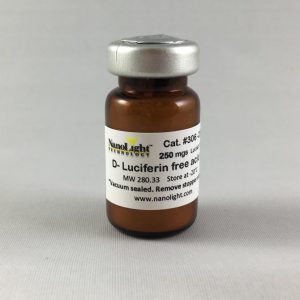
Firefly D-Luciferin Free Acid >99% (Photinus pyralis, pyrophorus, and Elateridea substrate luciferins) This is the FREE ACID and not a water soluble salt, such as the Potassium or Sodium salts. This requires reconstitution using alkaline buffers. 
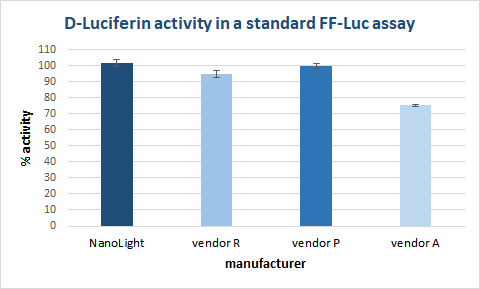
| |||||||||||||

| Used to cool products during transit. | 
Used to cool products during transit. Used to cool products during transit. | ||||||||||||||
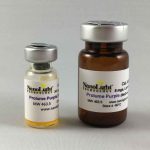

| 369 | Methoxy e-Coelenterazine analog quenching the emission maxi ... | 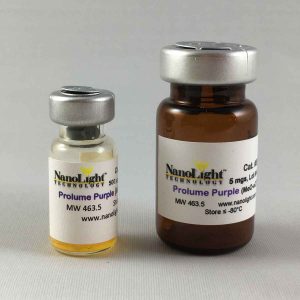
Prolume Purple or methoxy e-Coelenterazine (Me-O-e-CTZ) is a new synthetic analogue of e-Coelenterazine with an additional methoxy group quenching the emission maximum from 475 nm to 405 nm. Nanolight™ Technologies developed Prolume Purple. (US Patent 2013/057660) Prolume Purple exhibits an up to 13-fold higher luminescence than CTZ400a (“deep blue C”). 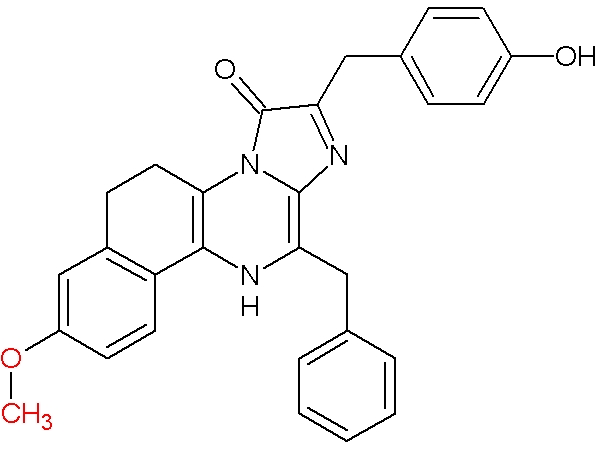
Comparison to CTZ400a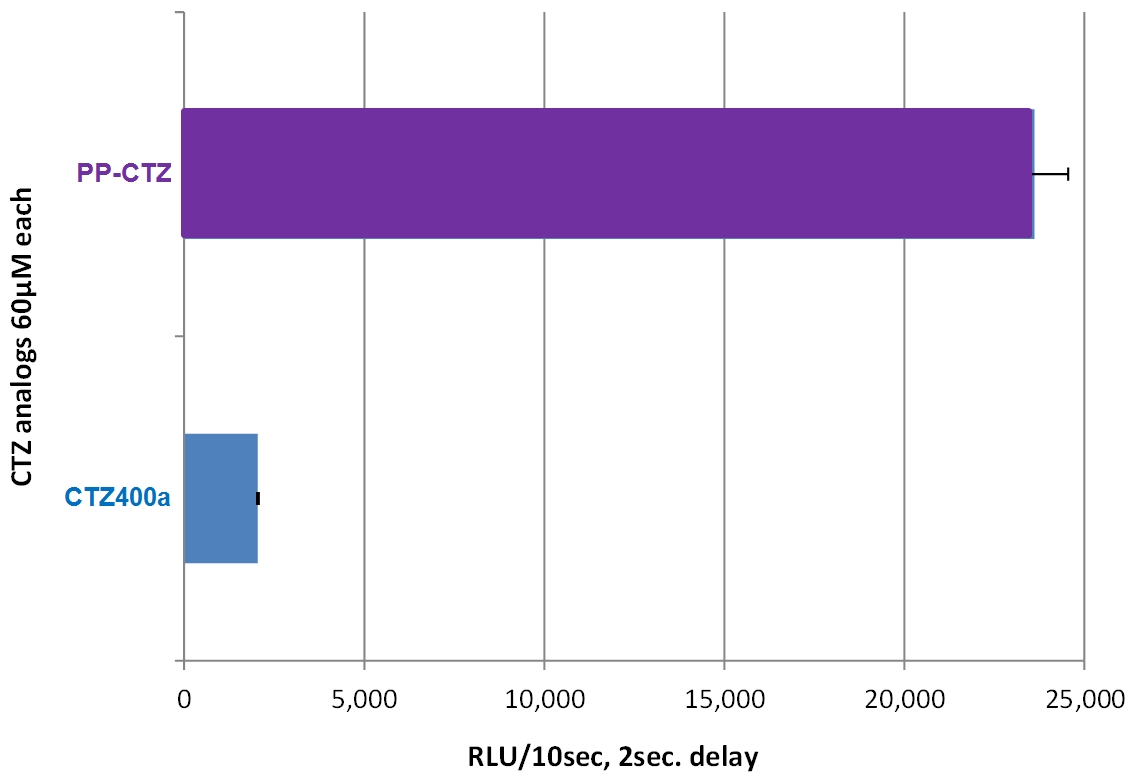
Emission spec with Renilla Luciferases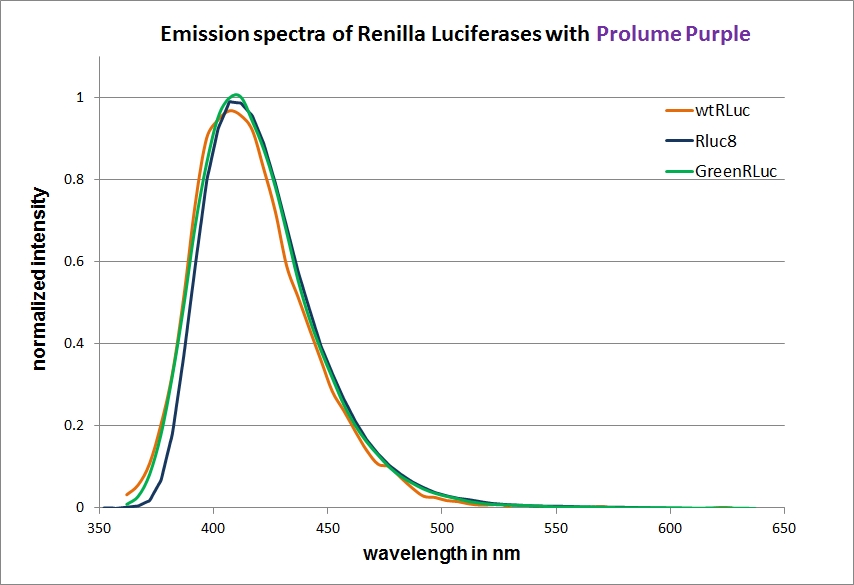
The advantages of lyophilized luciferins are:
The luciferin is shipped as filtered, lyophilized, batch controlled substrate | |||||||||||||

| 367 | Prolume Purple II or Methoxy-Coelenterazine-Methoxy (Me-O- ... | 
Prolume Purple II or Methoxy-Coelenterazine-Methoxy (Me-O-CTZ-O-Me) is a new synthetic analogue of Coelenterazine with two additional methoxy groups emitting at 400nm with Renilla Luciferase 8 (RLuc8) and Green Renilla Luciferase. Nanolight™ Technologies developed Prolume Purple II (US Patent 2013/057660).
Prolume Purple II exhibits an up to 5-fold higher luminescence than CTZ400a (“deep blue C”).
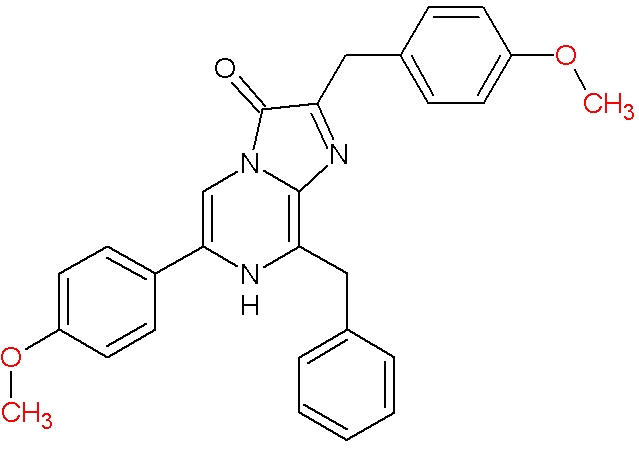
Activity compared to CTZ-400a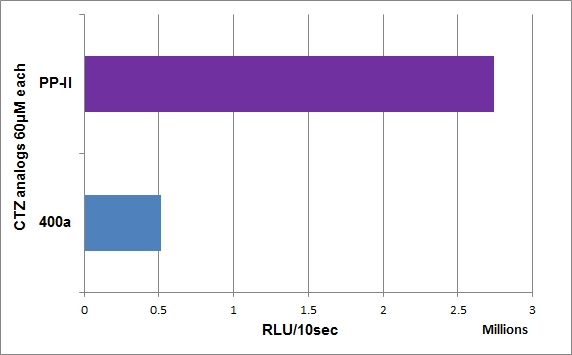
Emission specs with RLuc8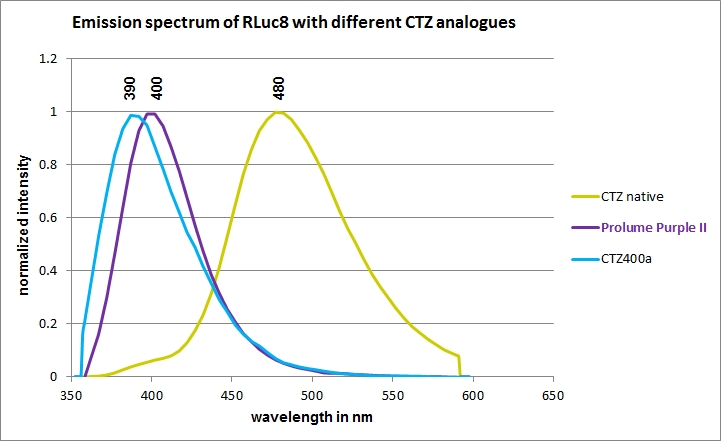
The advantages of lyophilized luciferins are:
The luciferin is shipped as filtered, lyophilized, batch controlled substrate | |||||||||||||

| 365 | Methoxy-eCoelenterazine-F (Me-O-eCTZ-F) is a new synthetic a ... | 
Methoxy-eCoelenterazine-F (Me-O-eCTZ-F) is a new synthetic analogue of e-Coelenterazine-F with an additional methoxy groups emitting at 410nm with Green Renilla Luciferase. Nanolight™ Technologies developed Prolume Purple III. (US Patent 2013/057660) Prolume Purple III exhibits an up to 10-fold higher luminescence than CTZ400a (“deep blue C”).
If you are using RLuc8 or wildtyp Renilla Luc please use Prolume Purple (Cat.# 369). 
Activity compared to other CTZs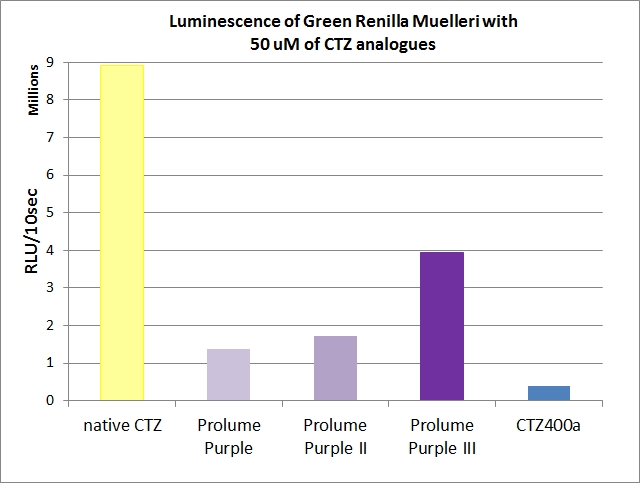
Emission specs with Green RLuc
The advantages of lyophilized luciferins are
The luciferin is shipped as filtered, lyophilized, batch controlled substrate for 250µg and 1mg (4x 250µg) aliquots.
10 mgs are packed as regular powder in one tube.
| |||||||||||||

| 363 | Prolume Purple IV or Methoxy-Coelenterazine-Iodine (Me-O-CT ... | 
Prolume Purple IV or Methoxy-Coelenterazine-Iodine (Me-O-CTZ-I) is a new synthetic analogue of Coelenterazine-I with an additional methoxy group. So far we were not able to determine a luciferase that is working with this unique compound. Activity with RLuc8, Rluc3 and Green Renilla Luciferase were very low.
Nanolight™ Technologies developed Prolume Purple IV. (US Patent 2013/057660).

Advantages
The luciferin is shipped as filtered, lyophilized, batch controlled substrate for 250µg and 1mg (4x 250µg) aliquots.
10 mgs are packed as regular powder in one tube.
| |||||||||||||
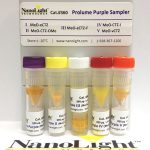
| 360 | Nanolight™ Technologies patented methoxy Coelenterazine c ... | 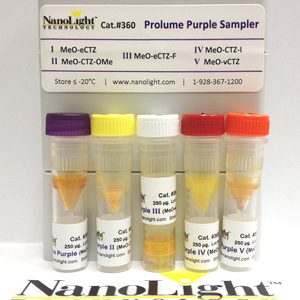
Nanolight™ Technologies patented methoxy Coelenterazine compounds are now available as a comprehensive sampler kit. Nanolight Technology is pleased to introduce these newly developed coelenterazine compounds. Your feedback is appreciated, if you find any additional luciferases or luciferase mutants that work with these compounds, please contact us at info@prolume.com. Prolume Purple Sampler content (250 ug each) | |||||||||||||

| 361 | Methoxy-v-Coelenterazine-Methoxy (Me-O-v-CTZ-O-Me) is a new ... | 
Methoxy-v-Coelenterazine-Methoxy (Me-O-v-CTZ-O-Me) is a new synthetic analogue of v-Coelenterazine with two additional methoxy groups. So far we were not able to determine a luciferase that is working with this unique compound. Activities with RLuc8, Rluc3 and Green Renilla Luciferase are very low. 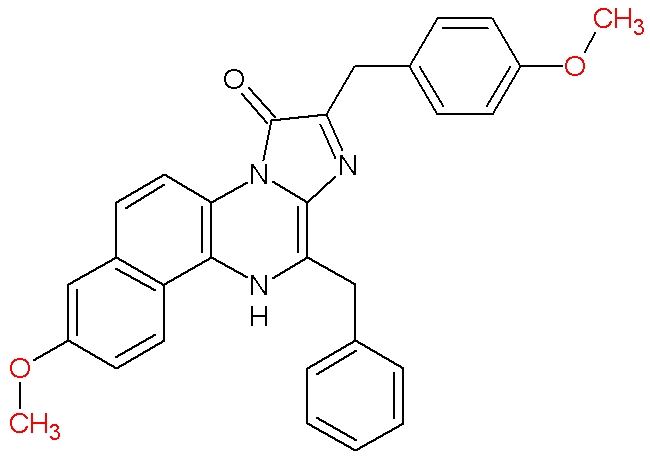
Advantages
The luciferin is shipped as filtered, lyophilized, batch controlled substrate for 250µg and 1mg (4x 250µg) aliquots.
10 mgs are packed as regular powder in one tube.
| |||||||||||||

| 107 | pUC18 Obelin Photoprotein ... | ||||||||||||||

| 106 | pUC19 Aequorin Photoprotein Vector ... | ||||||||||||||

| 307L | A photoprotein originating from the jellyfish Aequorea victo ... | 
A photoprotein originating from the jellyfish Aequorea victoria emits light in the presence of a trace amount of Ca2+ without the requirement of any other cofactor. Aequorin was “charged” with unmodified (native) Coelenterazine and will emit light at 465 nm upon Ca2+ contact. Aequorin photoprotein (untagged) is recombinantly produced in E. coli, purified via multi-step chromatography and appears as a yellow liquid. Concentration 2 mg/ml in 1.2M (NH4)2SO4, 250 μl per tube Sequence
Applications positive control in Ca2+ assays Purity > 95% by SDS-PAGE 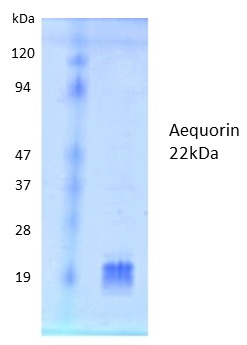
|



